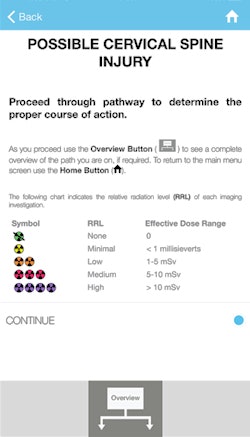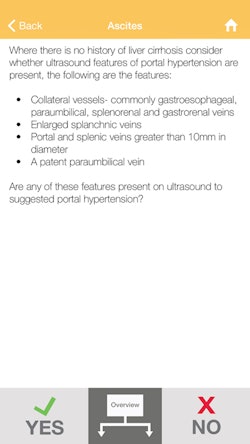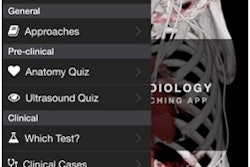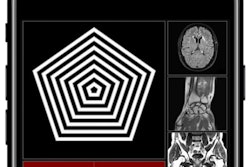
AuntMinnie.com presents the next article in an ongoing series highlighting notable mobile apps in radiology. In this installment, we take a look at the Diagnostic Imaging Pathways (DIP) iOS app, which provides mobile access to the DIP online imaging decision-support and educational tool developed in Australia.
We chatted recently with developer Dr. Manusha Ratnayake to learn more about the app. Ratnayake is a radiology resident in the Western Australia radiology training program and developed the app while serving as a research fellow with DIP.
AuntMinnie: What inspired you to create this app?
Ratnayake: The app was inspired by a desire to improve the day-to-day efficiency of how doctors go about making decisions in regard to referrals for medical imaging.
 Dr. Manusha Ratnayake.
Dr. Manusha Ratnayake.From previous experience, both personally and from colleagues in all spectrums of clinical medicine, the time pressures placed on clinicians often impede the ability to make informed and evidence-based decisions on imaging. Added to this are logistical and cost considerations like access to computing hardware and journal subscriptions that are also often barriers to making these informed decisions. The most obvious solution was to develop a freely available app to circumvent these problems, especially given the near-ubiquitous penetration of smartphones.
From a personal perspective, I'm a strong supporter of Free Open Access Medical Education (FOAM). Given the importance of radiology in the provision of medical care, it was important to me in developing this app that it be freely available to as many people as possible. With the success of fantastic resources like Radiopaedia, it is evident that there is a need to continually develop novel solutions to promote a culture of education and improved patient care.
What problem does the app help solve?
In short, this app seeks to help referrers and future referrers of medical imaging interactively determine the most appropriate imaging investigation for over 160 clinical scenarios. In developing the app, we were acutely aware of the increasing demands and complexities placed on clinicians in regard to medical imaging. Therefore, a fundamental tenet of the app is the ability to make extremely rapid inquiries into choosing the most appropriate imaging investigation in specific clinical scenarios.
 The DIP app guides referring physicians through pathways to determine the best imaging choices. All images courtesy of Dr. Manusha Ratnayake.
The DIP app guides referring physicians through pathways to determine the best imaging choices. All images courtesy of Dr. Manusha Ratnayake.Whether it be the intern on their first overnight cover shift, the rural general practitioner, the busy hospital clinician, or the medical student, this app, we hope, will be of great use to all. The pathways and academic content are based on the Diagnostic Imaging Pathways website, with a primary purpose to allow users portable access to flowcharts without being online.
Of particular note, we have sought to redress previous barriers in regard to accessing this kind of information, which include logistical considerations (e.g., Internet access, computer access, remote geography, time pressures) and cost considerations. Ultimately, we believe this app will give the referrer greater confidence in choosing the most appropriate imaging investigation. This will improve patient care by utilizing evidence-based principles to increase diagnostic yield, reduce costs to the healthcare system by decreasing the volume of inappropriate imaging, and reduce patient exposure to ionizing radiation where there is no compensating benefit.
Could you also share some background on the Diagnostic Imaging Pathways project?
DIP is an Australian-based resource; it's a locally and internationally recognized online imaging decision-support and educational tool founded in 2003 by the current chief editor, Dr. Richard Mendelson. It is targeted at referrers and future referrers to diagnostic imaging, imaging providers, and other health professionals.
How did you develop the app, and what was the overall experience?
The development of the app began with concept planning in March 2014. From that point we secured the services of software development firm Sigmalogic to assist in developing the software interface. Collectively, the development team went through various iterations of how the app would work in regard to user interface and appearance. We also canvassed the opinions of a variety of practicing clinicians.
Once consensus was achieved, development officially began in June 2014. The core aspect of app development was the creation of interactive blueprints from existing pathways on the DIP parent site; this proved a time-intensive aspect of app development, as each pathway was translated into an interactive format. A key focus was maintaining intuitive, seamless navigation of pathways balanced with providing the user with clinically relevant information along the way. The app was completed in January 2015.
I found developing the app to be an extremely rewarding and enjoyable experience that I would thoroughly recommend should anyone have the idea and opportunity. The development process inevitably presents many demands and challenges, but through careful application and keeping the end goal in mind, these can be easily overcome.
Who is the target audience, and how do you envision that the app will be used?
The target audience for this app is primarily those with a medical background, be it medical students or practicing clinicians. Any medical practitioner who requests imaging will find this a useful resource to assist in determining the most appropriate imaging modality in specific clinical situations.
 An interactive approach guides users about appropriate imaging decisions.
An interactive approach guides users about appropriate imaging decisions.This app can be used in a myriad of different situations, whether it's the busy hospital environment, primary care settings, or in remote locations where access to resources is limited. Being a smartphone application, it can be used potentially anywhere without the need for an Internet connection.
Is it suitable for users around the world?
Taking into account the nuances in clinical practice between different countries and logistical access to imaging modalities, it is envisaged this app could be utilized by potentially anyone in the world with English comprehension skills. Many of the pathways focus on common clinical conditions that are seen throughout the world. Our main website has users from throughout the world, and we hope that's replicated with the app.
What are the app's most important features?
This is a free application and it's available for standalone use; once downloaded, the application is fully accessible without requiring an Internet connection. It includes over 160 regularly reviewed and updated pathways from a variety of clinical areas ranging from primary care to specialist and subspecialist fields. Recommendations for imaging are based on in-depth literature reviews and expert multidisciplinary medical, surgical, radiologist, and primary care physician consensus opinion.
The clinically relevant education material throughout all pathways can be incorporated into the medical assessment. In addition, there's clearly defined and consistent communication of radiation levels for the user throughout the application, as well as the ability to access an overview of the pathway flow diagram at any point of the pathway navigation. The app also utilizes a novel interactive approach that helps users determine the best imaging investigation depending on the choices they make in the clinical scenario. Alternative imaging recommendations are made where applicable.
How many users are there currently?
The app was released in May, and we currently have had approximately 1,300 downloads with very positive feedback thus far.
What are your future plans for the app? Are there any new features or content in the works? Do you plan to develop a version for Android?
Our immediate plans are to release an Android version of the app, for which there is a strong demand. We are currently testing the Android version and hope to release this in the very near future. We are planning to introduce a dedicated trauma pathway section and also to develop a "favorites" tab where users can access frequently accessed pathways. Any other features will be guided by the user base of the app, and we encourage users to please contact us with suggestions as to how we can improve the experience for them.
Have you developed any other apps, or do you intend to?
Additional projects under development are a standalone ionizing radiation training module and also a pediatric imaging module. This was the first app that I've developed and I certainly hope to cultivate this app further and make it a valuable resource for users. I have some projects in mind for new apps that will hopefully make their way to production in the not too distant future while progressing through my radiology training.
The Diagnostic Imaging Pathways app can be downloaded for free from the iTunes Store.




















